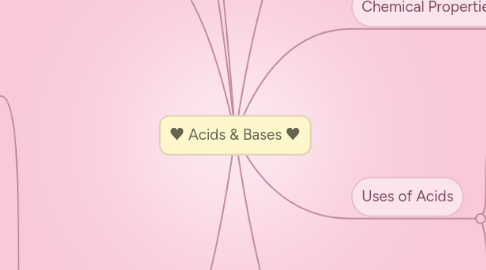
1. Physical Properties of Acids
1.1. Conduct electricity when dissolved in water
1.2. Sour taste
1.3. Turn damp blue litmus paper red
1.4. pH value < 7
2. Chemical Properties of Acids
2.1. Reaction with reactive metals ((unreactive metals are copper, silver and gold))
2.1.1. Acid + Reactive metal --> Salt + Hydrogen gas
2.1.1.1. Effervescence is observed. Hydrogen extinguishes a lighted splint with a 'pop' sound.
2.2. Reaction with carbonates
2.2.1. Acid + Metal Carbonate --> Salt + Water + Carbon Dioxide gas
2.2.1.1. Effervescence is observed. Carbon dioxide forms a white precipitate when bubbled into limewater.
2.3. Reaction with metal oxides/hydroxides ((neutralisation))
2.3.1. Acid + Metal oxide/hydroxide --> Salt + Water
3. Uses of Acids
3.1. Hydrochloric Acid
3.1.1. Remove impurities such as rust from metals
3.2. Sulfuric Acid
3.2.1. Manufacture of detergents
3.2.2. Manufacture of fertilizers ((ammonium sulfate))
3.2.3. As battery acid in cars
3.2.3.1. Dilute sulfuric acid reacts with lead plates and lead (IV) oxide plates in the battery to generate electrical energy
3.3. Ethanoic Acid
3.3.1. Food Preservative and Flavor Enhancer
4. Physical Properties of Alkalis
4.1. Bitter taste
4.2. Turn damp red litmus paper blue
4.3. pH Value > 7
4.4. Soapy/Slippery feel
5. Chemical properties of Alkalis
5.1. Reactions with Acids ((neutralisation))
5.1.1. Acid + Base/Alkali --> Salt + Water
5.2. Reaction with Ammonium salts
5.2.1. Alkali + Ammonium Salt --> Salt + Water + Ammonia gas
5.2.1.1. A pungent gas is produced. Ammonia turns moist reds litmus paper blue.
5.3. Reaction with metal salt solutions
5.3.1. Alkali (metal A) + Metal salt solution (metal B) --> Metal salt (metal A) + Metal hydroxide (metal B)
6. Uses of Alkalis
6.1. Calcium oxide/hydroxide
6.1.1. Neutralise excess acidity in soil
6.2. Sodium/Potassium hydroxide
6.2.1. Make soaps and detergents
6.3. Aqueous Ammonia
6.3.1. Make fertilizers
6.3.2. Used in window cleaners to remove grease from glass
6.4. Magnesium hydroxide
6.4.1. Used in toothpaste to neutralise acids on our teeth
6.4.2. Used in antacid to relieve the pain of indigestion
7. pH scale
7.1. pH of a solution is a measure of the relative acidity, alkalinity or neutrality of the solution
7.2. Can be measured quantitatively using the Universal Indicator paper/solution of pH meter
7.2.1. Universal Indicator
7.2.1.1. Mixture of dyes
7.2.1.2. 2 forms
7.2.1.2.1. Universal Indicator paper: White
7.2.1.2.2. Universal Indicator solution: Green
7.2.2. Litmus Papers
7.2.2.1. Used to determine whether solution is acidic, neutral or alkaline qualitatively based on the color change
7.2.2.2. Cannot provide information about degree of acidity/alkalinity
7.2.3. pH meter/pH probes attached to data loggers
7.2.3.1. can be immersed into solution to measure its pH
7.2.3.2. Measures specific pH value up to 2dp
7.2.4. Other indicators
7.2.4.1. Methyl Orange
7.2.4.1.1. Turns red in acidic solution; Turns yellow in alkaline solution
7.2.4.1.2. pH range in which it changes color: 3 ~ 5
7.2.4.2. Screened Methyl Orange
7.2.4.2.1. Turns violet in acidic solution; Turns green in alkaline solution
7.2.4.2.2. pH range in which it changes color: 3 ~ 5
7.2.4.3. Bromothymol Blue
7.2.4.3.1. Turns yellow in acidic solution; Turns blue in alkaline solution
7.2.4.3.2. pH range in which it changes color: 6 ~ 8
7.2.4.4. Phenolphthalein
7.2.4.4.1. Turns colorless in acidic solution; Turns pink in alkaline solution
7.2.4.4.2. pH range in which it changes color: 8 ~ 10
7.3. pH measures the concentration of hydrogen ions, H+, present in a solution
7.4. *Ranges from 0 ~ 14
8. Importance of pH in the acidity in soils
8.1. Most plants grow well in neutral or slightly acidic soil of pH around 6.5
8.2. Soil may become too acidic
8.2.1. Pollution from Acid rain
8.2.2. Addition of excess fertilisers
